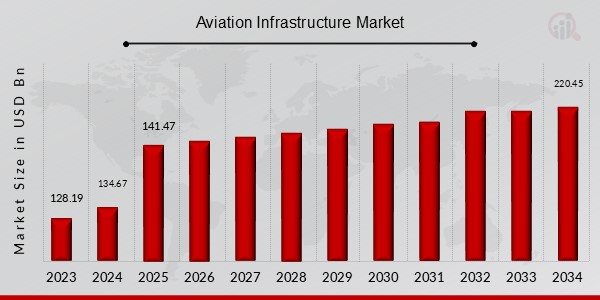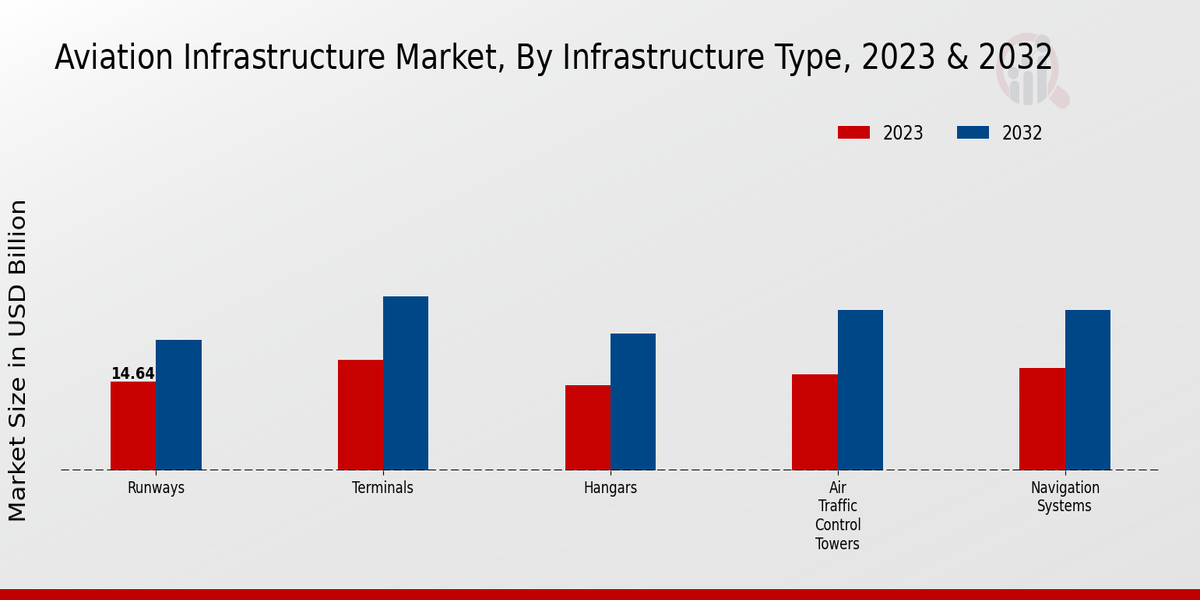Global Aviation Infrastructure Market Overview
Aviation Infrastructure Market Size was estimated at 134.67 (USD Billion) in 2024. The Aviation Infrastructure Industry is expected to grow from 141.47 (USD Billion) in 2025 to 220.45 (USD Billion) by 2034. The Aviation Infrastructure Market CAGR (growth rate) is expected to be around 5.1% during the forecast period (2025 - 2034).

Source Primary Research, Secondary Research, MRFR Database and Analyst Review
Key Aviation Infrastructure Market Trends Highlighted
The aviation infrastructure market has experienced significant advancements in recent years, driven by technological innovations, increased passenger demand, and a focus on sustainability. Key trends include the adoption of advanced air traffic management systems, the development of sustainable aviation fuels, and the integration of artificial intelligence (AI) and automation in airport operations.
Airports are increasingly adopting digital technologies to enhance passenger experiences, optimize operations, and improve security. Sustainability remains a major focus, with airports investing in renewable energy sources, electric ground vehicles, and waste management systems. The proliferation of unmanned aerial vehicles (UAVs) is also shaping the market, with airports developing infrastructure to accommodate this growing segment. The increasing popularity of low-cost carriers and the expansion of air travel into emerging markets are creating opportunities for growth in aviation infrastructure.
Aviation Infrastructure Market Drivers
Growing Air Traffic and Passenger Demand
The aviation industry has witnessed a steady increase in air traffic and passenger demand in recent years, driven by factors such as rising disposable income, increasing urbanization, and ization. This growth has put a strain on existing aviation infrastructure, creating a need for new and upgraded facilities to accommodate the growing number of passengers and flights. The expansion of low-cost carriers and the emergence of new travel destinations have further contributed to the demand for improved aviation infrastructure.This growing demand is expected to remain a key driver of the Aviation Infrastructure Market Industry in the coming years.
Technological Advancements and Innovation
Technological advancements and innovation play a crucial role in shaping the Aviation Infrastructure Market Industry. The adoption of new technologies, such as advanced air traffic management systems, automation, and sustainable solutions, can improve the efficiency and safety of aviation operations. These technologies can help optimize airspace utilization, reduce delays, and enhance overall airport operations. Additionally, investments in research and development for new materials, construction methods, and energy-efficient technologies can lead to the development of more sustainable and cost-effective aviation infrastructure.
Government Regulations and Policies
Government regulations and policies have a significant impact on the Aviation Infrastructure Market Industry. Governments play a crucial role in setting safety standards, environmental regulations, and economic policies that affect the development and operation of aviation infrastructure. Stringent regulations regarding safety, security, and environmental protection can influence the design, construction, and maintenance of aviation facilities.Government policies related to funding, incentives, and partnerships can also shape the investment landscape and drive the growth of the aviation infrastructure sector.
Aviation Infrastructure Market Segment Insights
Aviation Infrastructure Market Infrastructure Type Insights
The Aviation Infrastructure Market is segmented by Infrastructure Type Runways, Terminals, Hangars, Air Traffic Control Towers, Navigation Systems, Cargo Handling Facilities, Support Facilities Others. Terminals are expected to account for the largest share in 2023 on account of increasing passenger traffic and the growing need for efficient baggage handling systems.The runways segment is expected to register the highest growth over the forecast period due to rising demand for new and expanding airports. The Hangars segment is anticipated to grow for similar reasons, as well as increasing demand for commercial aircraft storage facilities. The air traffic control towers segment is anticipated to grow at a significant rate, owing to the surging need for safe and well-organized air traffic. Navigation systems, too, are expected to benefit from technological advancements, such as GPS and ADS-B. Cargo handling facilities are anticipated to grow at a similar pace, owing to the increasing volume of air cargo.Support facilities are expected to grow steadily due to rising demand for more efficient and reliable ground support equipment. The growth of the market is primarily attributable to some key factors, such as increasing passenger traffic, rising demand for new and larger airports, and growing uptake of new technologies. The Asia-Pacific is anticipated to be the fastest-growing market during the forecast period, owing to huge and ever-increasing demand for air travel and logistics. North American and European markets are also expected to register significant growth during the forecast period.

Source Primary Research, Secondary Research, MRFR Database and Analyst Review
Aviation Infrastructure Market Ownership Insights
The Aviation Infrastructure Market, based on ownership, is segmented into government-owned, privately-owned, and public-private partnerships. A government-owned segment is a type of aviation infrastructure owned and operated by national or local governmental agencies. Privately- owned infrastructure for aviation is the facility run by individual or company officers. A public-private partnership, on the other hand, is a hybrid model that combines elements of government and private ownership. In this type of partnership, a government grants concession to a private company to finance, build, and operate the aviation infrastructure project.In this approach, the private company carries the risk and reward of the project to be shared with the government. On the basis of ownership, in 2023, the government-owned market segment accounted for the largest share of the Aviation Infrastructure Market revenue, with a value of USD 72.34 billion. The privately owned businesses segment is anticipated to register a faster CAGR of 5.3% from 2024 to 2030, with a value of USD 67.66 billion by 2032. By 2032, the PPP segment is expected to be valued at USD 50.0 billion in the Aviation Infrastructure Market.Increased demand for private sector investment in aviation infrastructure is driving the PPP segment’s growth.
Aviation Infrastructure Market Size Insights
The Aviation Infrastructure Market is segmented by size into small airports (less than 1 million passengers per year), medium airports (1-5 million passengers per year), and large airports (over 5 million passengers per year). The large airports segment is expected to account for the largest share of the market in 2023, with a market value of USD 122.03 billion. This is due to the increasing number of international travelers and the growing demand for air travel in emerging markets. This is due to the increasing number of regional airlines and the growing popularity of low-cost carriers.The small airports segment is expected to account for the smallest share of the market in 2023, with a market value of USD 190.0 billion. However, this segment is expected to grow at a steady rate during the forecast period.
Aviation Infrastructure Market Location Insights
The location segment of the Aviation Infrastructure Market is categorized into urban, suburban, and rural areas. Among these, urban areas are projected to hold the largest market share during the forecast period. The growth in air travel, coupled with the increasing population density in urban areas, is driving the demand for aviation infrastructure in these regions. For instance, in 2023, the Aviation Infrastructure Market revenue in urban areas was valued at approximately USD 75.5 billion, and it is expected to reach USD 105.8 billion by 2032, exhibiting a CAGR of 5.2%.The expansion of existing airports and the construction of new ones in urban centers to accommodate the growing passenger traffic are key factors contributing to the market growth in this segment.
Aviation Infrastructure Market Regional Insights
The Aviation Infrastructure Market is segmented into North America, Europe, APAC, South America, and MEA. Among these regions, North America held the largest market share in 2023 and is expected to maintain its dominance throughout the forecast period. The region's strong aviation industry, coupled with government initiatives to modernize and expand airport infrastructure, is driving growth in this segment. Europe is another key region in the Aviation Infrastructure Market, with a significant number of major airports and a well-established aviation sector.The region is expected to witness steady growth in the coming years, driven by increasing passenger traffic and the need for infrastructure upgrades. APAC is a rapidly growing region in the Aviation Infrastructure Market, with China and India being major contributors. The region's expanding middle class and increasing air travel demand are fueling growth in this segment. South America and MEA are expected to witness moderate growth in the coming years, as governments in these regions prioritize infrastructure development to support economic growth and tourism.

Source Primary Research, Secondary Research, MRFR Database and Analyst Review
Aviation Infrastructure Market Key Players And Competitive Insights
Top key players in the Aviation Infrastructure market are focusing on developing innovative technologies to reduce operational costs and increase operational efficiency. These leading key players in the Aviation Infrastructure industry are investing a substantial amount in research and development to develop such a solution. The Aviation Infrastructure market is highly competitive and several leading key players have a significant share of the market in this industry. Leading key players in this industry are innovating and expanding their product offerings to meet evolving aviation requirements. This competitive environment is expected to remain throughout the predicted period, with different regional and key players competing in the market to gain a high revenue share.
Key players in the Aviation Infrastructure market, such as Airports Company South Africa, are the key players in the market and have a significant presence in the African market. Airports Company South Africa operates several airports in South Africa, such as OR Tambo International Airport in Johannesburg. This is the most active airport in Africa. This key player in the Aviation Infrastructure market is also investing in their airports. ACSA is currently working on several expansion projects and is also replacing and upgrading its equipment to cater to the growing demand for air travel in the region. They are focusing on developing new technologies to upgrade their airports and improve their operational performance.
Fraport AG is another leading player in the Aviation Infrastructure market and is constantly expanding its presence in different countries in Europe, North America, and South America. This German company is known for its experience in airport management, operations, and technology. This key player constantly invests in new technologies to improve aviation efficiency. This key player in the Aviation Infrastructure market is constantly expanding its presence in the market. Recently, they acquired airports in Greece and in Peru, and they plan to expand their market share by acquiring new airports in their portfolios.
Key Companies in the Aviation Infrastructure Market Include
- Airbus
- Lockheed Martin
- Boeing
- IT
- L3 Communications
- Textron
- Rockwell Collins
- Northrop Grumman
- Leonardo
- BAE Systems
- Honeywell
- Safran
- General Electric
- Thales
Aviation Infrastructure Market Industry Developments
The aviation infrastructure market is projected to reach a valuation of USD 190.0 billion by 2032, expanding at a CAGR of 5.05% from 2023 to 2032. This growth is driven by increasing air passenger traffic, rising demand for air cargo services, and government initiatives to modernize and expand airport infrastructure. Recent news developments in the market include the opening of the new Istanbul Airport, which is one of the largest airports in the world, and the ongoing construction of the Beijing Daxing International Airport, which is expected to be completed in 2025. These developments are indicative of the growing demand for aviation infrastructure worldwide.
Aviation Infrastructure Market Segmentation Insights
- Aviation Infrastructure Market Infrastructure Type Outlook
- Runways
- Terminals
- Hangars
- Air Traffic Control Towers
- Navigation Systems
- Cargo Handling Facilities
- Support Facilities
- Aviation Infrastructure Market Ownership Outlook
- Government-owned
- Privately-owned
- Public-private partnerships
- Aviation Infrastructure Market Size Outlook
- Small airports (less than 1 million passengers per year)
- Medium airports (1-5 million passengers per year)
- Large airports (over 5 million passengers per year)
- Aviation Infrastructure Market Location Outlook
- Aviation Infrastructure Market Regional Outlook
- North America
- Europe
- South America
- Asia Pacific
- Middle East and Africa
| Report Attribute/Metric |
Details |
| Market Size 2024 |
134.67(USD Billion) |
| Market Size 2025 |
141.47(USD Billion) |
| Market Size 2034 |
220.45 (USD Billion) |
| Compound Annual Growth Rate (CAGR) |
5.1%(2025 - 2034) |
| Report Coverage |
Revenue Forecast, Competitive Landscape, Growth Factors, and Trends |
| Base Year |
2024 |
| Market Forecast Period |
2025 - 2034 |
| Historical Data |
2021 - 2024 |
| Market Forecast Units |
USD Billion |
| Key Companies Profiled |
Airbus ,Lockheed Martin ,Boeing ,ITT ,L3 Communications ,Textron ,Rockwell Collins ,Northrop Grumman ,Leonardo ,BAE Systems ,Honeywell ,Safran ,General Electric ,Thales |
| Segments Covered |
Infrastructure Type ,Ownership ,Size ,Location ,Regional |
| Key Market Opportunities |
1 Airport Terminal Modernization2 Air Traffic Management Upgrades3 Runway Expansion and Rehabilitation4 Cargo Terminal Automation5 Sustainable Energy Infrastructure |
| Key Market Dynamics |
Increasing passenger traffic Government investments in infrastructure Technological advancements Sustainability concerns Growing urbanization |
| Countries Covered |
North America, Europe, APAC, South America, MEA |
Frequently Asked Questions (FAQ) :
The aviation infrastructure market is expected to reach USD 220.45 billion by 2034, exhibiting a CAGR of 5.1% from 2025 to 2034.
The key drivers of the market include increasing air travel demand, rising disposable income, government initiatives to enhance airport infrastructure, and technological advancements in the aviation sector.
The major application segments of the market include airport terminals, runways, air traffic control systems, and cargo handling facilities.
The key geographical regions in the market are North America, Europe, Asia-Pacific, Latin America, and the Middle East & Africa.
Some of the key competitors in the market include Airbus, Boeing, Bombardier, Embraer, and Leonardo.
Major trends in the market include the adoption of sustainable practices, the implementation of smart technologies, and the expansion of airport infrastructure in emerging economies.
The challenges faced by the market include rising construction costs, environmental concerns, and the need for skilled workforce.
Growth opportunities in the market include the development of new airports, the expansion of existing airports, and the adoption of innovative technologies.
The aviation infrastructure market is expected to grow from USD 122.03 billion in 2023 to USD 190.0 billion by 2032, exhibiting a CAGR of 5.05% from 2023 to 2032.
Key factors that will shape the future of the market include the increasing demand for air travel, the development of new technologies, and the growing focus on sustainability.

















